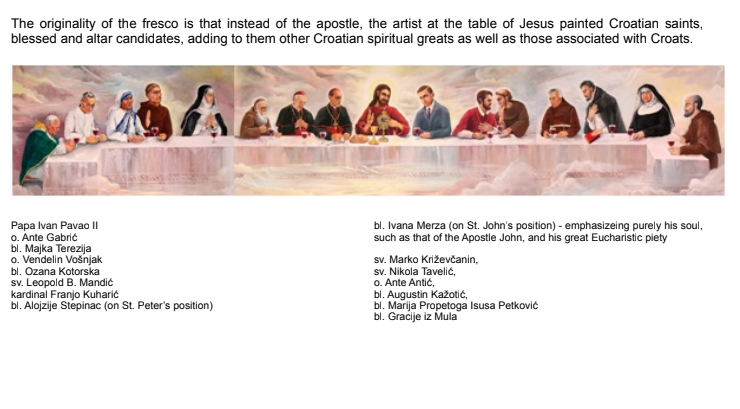The Last Supper in Ludbreg, Croatia's Miracle Town: Meet the Croatian Saints
November 10, 2019 - The Last Supper in Ludbreg, the only town in Croatia with a physical miracle certified by the Vatican has an unusual fresco with the disciples of Jesus replaced by Croatian saints and holy people. So who exactly are they?
Almost everyone I have spoken to about this in Croatia in recent weeks has either had no idea whatsoever, or very limited knowledge, apart from about 2-3 people. With more than one million tourists a year in Medjugorje in neighbouring Bosnia and Herzegovina, very few religious pilgrims going there have ever heard of Ludbreg, a small town in Varazdin County just north of Zagreb. And yet, with the Vatican has yet to recognise anything in Medjugorje, Ludbreg is home to the only physical miracle in all Croatia which has been certified by the Vatican. You can read the original story in full here, but to recap:

The Real Presence website gives a great overview of the history of Ludbreg's miracle.
In 1411 at Ludbreg, in the chapel of the Count Batthyany’s castle, a priest was celebrating Mass, during the consecration of the wine, the priest doubted the truth of transubstantiation, and the wine in the chalice turned into Blood. Not knowing what to do, the priest embedded this relic in the wall behind the main altar. The workman who did the job was sworn to silence. The priest also kept it secret and revealed it only at the time of his death. After the priest’s revelation, news quickly spread and people started coming on pilgrimage to Ludbreg. The Holy See later had the relic of the miracle brought to Rome, where it remained for several years. The people of Ludbreg and the surrounding area, however, continued to make pilgrimages to the castle chapel.
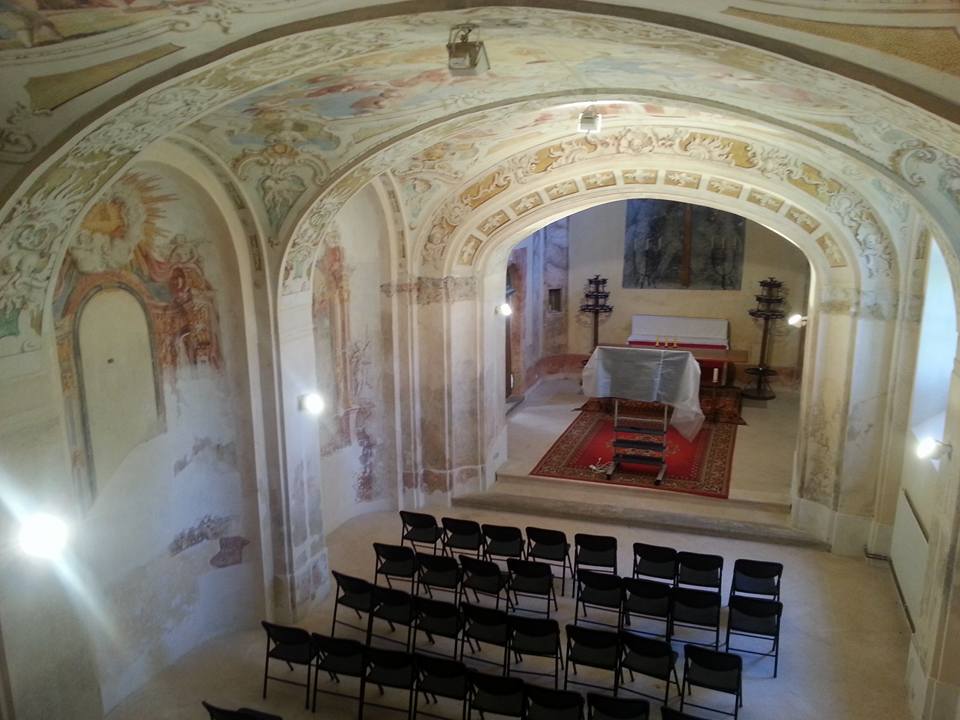
In the early 1500s, during the pontificate of Pope Julius II, a commission was convened in Ludbreg to investigate the facts connected with the Eucharistic miracle. Many people testified that they had received marvelous cures while praying in the relic’s presence. On April 14, 1513, Pope Leo X published a Bull permitting veneration off the holy relic which he himself had carried in procession several times through the streets of Rome. The relic was later returned to Croatia.
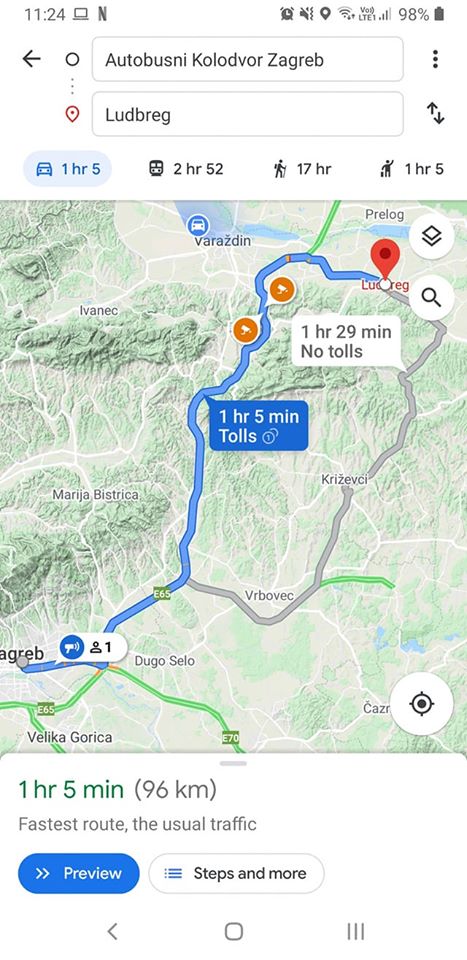
In the 18th century northern Croatia was ravaged by the plague. The people turned to God to call upon His help, and the Croatian Parliament did the same. During the session held on December 15, 1739 in the city of Varazdin, they vowed to build a chapel at Ludbreg in honor of the miracle if the plague ended. The plague was averted, but the promise vow was only fulfilled in 1994, when democracy was restored in Croatia. In 2005 in the votive chapel, the artist Marijan Jakubin painted a large fresco of the Last Supper in which Croatian saints and blesseds were drawn in place of the Apostles. St. John was replaced with Blessed Ivan Merz, who was included among the 18 most important Eucharistic saints in the Church’s history during the Synod of Bishops held in Rome in 2005. In the painting, Christ is holding in His hand a monstrance containing the relic of the Eucharistic miracle.
And that large fresco of Croatian saints and blesseds was incredible and very unique. I have never seen anything like it before. It was painted by Marijan Jakubin, an academic painter.
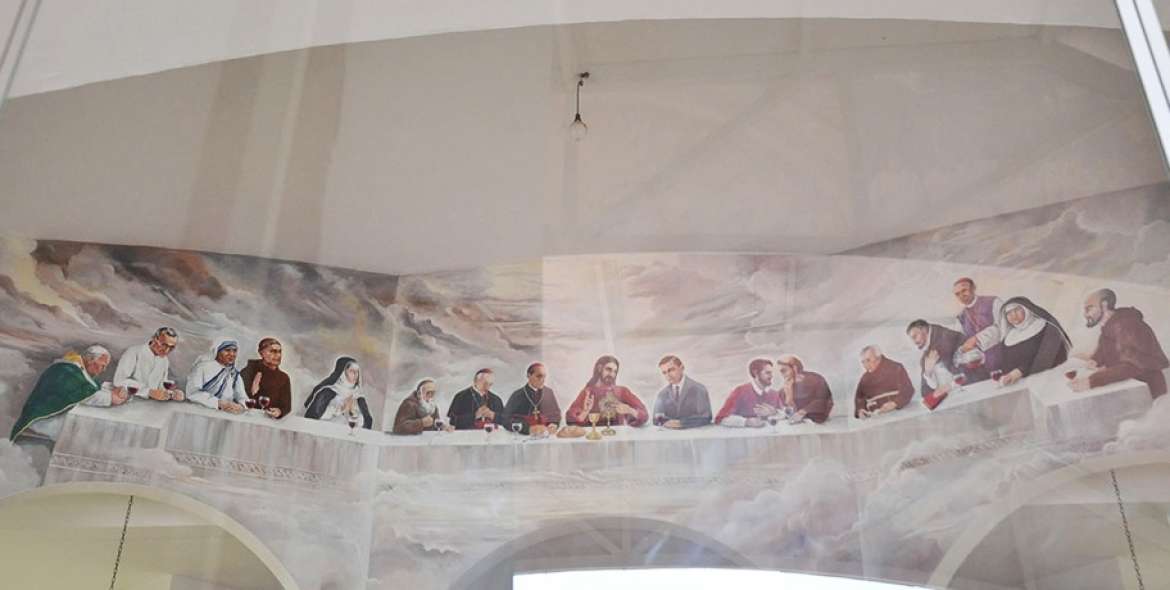
I have been to many churches in Croatia, but never seen anything like it.
So who are the people with Jesus at this very Croatian Last Supper in Ludbreg? From left to right, there is a brief description of each, apart from the very famous ones, Pope John Paul II, Mother Teresa, and Cardinal Stepinac.
Pope John Paul II
Father Ante Gabric - Born in Metkovic in 1915, Gabric joined the Jesuits at an early age. On October 20, 1938, after obtaining special permission from his Jesuit superiors, Gabric left for India, his ‘promised land,’ by steamship, where he became a very close aid to Mother Teresa. Exactly fifty years later to the day, October 20, 1988, he passed away.
Mother Teresa
Brother Vendelin Vosnjak - Born in Slovenia in 1861, Vendelin Vosnjak joined the Franciscan Order in 1878 and was ordained a priest i n1884. The founder of the Croatian Franciscan Province of Sv. Cyril and Methodius in 1900, he encouraged the restoration of spiritual life, churches and monasteries, as well as the publication of religious magazines. He was proclaimed a servant of God in 2000, and the process of his canonisation is ongoing. He died in 1933.
Osanna of Cattaro was a Catholic visionary from Kotor born in 1493 and who died in 1565. She was a teenage convert from Orthodoxy and became a Dominican tertiary and was posthumously venerated as a saint in Kotor. She was later beatified in 1934.
Saint Leopold B. Mandic (also known as Leopold of Castelnuovo) was born in 1866 and died on 30 July 1942. He was a Croatian Capuchin friar and Catholic priest, who suffered from disabilities that would plague his speech and stature. He developed tremendous spiritual strength in spite of his disabilities and became extremely popular in his ministry as a confessor, often spending 12–15 hours in the confessional. Although Mandic wanted to be a missionary in Eastern Europe, he spent almost all his adult life in Italy, living in Padua from 1906 until his death. He also spent one year in an Italian prison during World War I, since he would not renounce his Croatian nationality.[2] He also dreamed unceasingly about reuniting the Catholic and Orthodox churches and going to the Orient. He became known as an Apostle of Confession and an Apostle of Unity. He made a famous prayer that is the forerunner of today's ecumenism.As a result of the bombing during World War II, the church and part of the friary where Mandic lived were demolished, but his cell and confessional were left unharmed. He had predicted this before his death, saying, "The church and the friary will be hit by the bombs, but not this little cell. Here God exercised so much mercy for people, it must remain as a monument to God's goodness." Pope Paul VI beatified Leopold on 2 May 1976. He was canonized by John Paul II during the General Assembly of the Synod of Bishops on 16 October 1983. Leopold is hailed as the "Apostle of Unity".
Cardinal Franjo Kuharic (15 April 1919 – 11 March 2002) was a Croatian Catholic cardinal, who served as the Archbishop of Zagreb from 1970 until his resignation in 1997. The cardinal was often referred to as the "Rock of Croatia" known for his defence of human rights and his urging of peace and forgiveness during the independence conflict and the Bosnian War. Kuharic was also a vocal supporter of the cause for the canonization of Cardinal Alojz Stepinac (who had ordained him as a priest in 1945) and worked to rehabilitate the image of the cardinal during his episcopate while working towards Stepinac's 1998 beatification held in Zagreb. His cause for canonization commenced on 11 March 2012 and he has been titled as a Servant of God.
Cardinal Alojz Stepinac
Blessed Ivan Merz (16 December 1896 – 10 May 1928) was a Croatian lay academic, beatified by Pope John Paul II on a visit at Banja Luka, Bosnia and Herzegovina on June 22, 2003. Ivan Merz promoted the liturgical movement in Croatia and together with Ivo Protulipac created a movement for the young people, “The Croatian union of the Eagles” (“Hrvatski orlovski savez)”, inspired by the “Eucharistic Crusade,” which he had encountered in France. The Director of the Confraternity, Dave Ceasar Dela Cruz was elected as the Vice Postulator of the Cause for the Canonization of Blessed Ivan Merz on 19 March 2008 by the Vatican through the Congregation for the Causes of Saints.
Saint Marko Krizevcanin was a Croatian Roman Catholic priest, professor of theology and missionary, who was active in the 17th century. In the course of the struggle between Catholicism and Calvinism in the region then, he was executed for his faith. He has been declared a saint by the Catholic Church, the third Croat to be so honored.
Nikola Tavelic was a Franciscan missionary who died a martyr's death in Jerusalem on November 14, 1391, a Croatian friar. He was beatified as part of Nicholas Tavelic, O.F.M. and companions, which included friars from Italy and France. All four members of his group have been declared saints by the Catholic Church, making Tavelic the first Croatian saint.
Ante Antic (Sepurine, Prvic Island, April 16, 1893 - Zagreb, March 4, 1965), Croatian Catholic priest, Franciscan, confessor, spiritual leader, servant of God, candidate for sainthood. There has been a process since 1984 to declare him a saint. The cause was opened by Cardinal Franjo Kuharic; the case has been taking place in Rome since 1995. More than 5,000 hearings have been recorded. He is one of the most beloved priests of the past century in Croatia. On May 5, 2015, he received the title of Holy Servant of God.
Augustin Kazotic (1260 – 3 August 1323) was a Dalmatian-Croatian Roman Catholic prelate and professed member from the Order of Preachers who served as the Bishop of Lucera from 1322 until his death. Kazotic was a humanist and orator who had served first as the Bishop of Zagreb from 1303 until 1322. Kazotic studied in Paris before returning to his homeland where he began working in the missions and preaching in modern Bosnia. He was one of the first humanist figures to appear in southern Croatia. His reputation for personal holiness remained noted long after his death; this resulted in Pope Innocent XII confirming the late bishop's beatification in 1700.
Marija Petkovic is also known as "The Blessed Mary of Jesus Crucifi ed Petkovic"; (Croatian: Marija od Propetoga Isusa Petkovic, Italian Maria Di Gesù Crocifisso), (10 December 1892 - 9 July 1966) was the founder of the Catholic Congregation of the Daughters of Mercy. She was recognized by the Roman Catholic Church as a Venerable Servant of God on 8 May 1998, and was beatified by Pope John Paul II on 6 June 2003.
Gracija Kotorski (Muo, Boka Kotorska, 27th of November 1438 - Venice, 9th of November 1508), a beatified Catholic, Augustinian monk, fisherman and seaman. Born as Pavao Krilovic. Until his thirties, he lived in Boka Kotorska as a fisherman. Then he went out into the world sailing just like a sailor. On his visit to Venice in 1454, he was delighted with the sermon of Blessed Šimun Kamerin, and he encouraged him to give up his worldly life and devote himself to a religious path. He went to the Augustinian monastery on Ortone Hill near Padua, where he remained for 15 years.
To follow the latest from Croatia's miracle town of Ludbreg, click here.
(With thanks to Miranda Milicic Bradbury for additional research)
Ludbreg, Croatia's Miracle Town: Vatican-Recognised Unlike Medjugorje
November 2, 2019 - More than a million religious tourists visit Medjugorje every year, even though the Vatican has not authenticated anything there, but few know about the only Vatican-authenticated miracle in Croatia which can be visited. Meet the Eucharistic Miracle in Ludbreg.
My first visit to Croatia in what was then Yugoslavia was back in 1988. I remember overnighting in Zagreb before heading to the destination which was the main purpose of the trip.
Medjugorje.
As I was the product of nine years of Jesuit education in a British boarding school, the Catholic faith was never far away. Indeed, so strong was the influence that I went to voluntary mass six times a week at 07:20 before lessons began, and I even contemplated becoming a priest at one stage. And so when I learned of the alleged apparitions in Medjugorje, I knew I had to visit this miraculous place.
But when I arrived, there was nothing concrete to see. Apart, of course, from apartments, so many apartments. This was a small village which had exploded in just eight years after six children claimed to have been visited by the Virgin Mary while tending goats. More apparitions occurred, and the Virgin Mary sends a message to one of the (now adult) visionaries on the 25th of each month. But there was nothing to see, apart from the hill where the sightings allegedly happened, and a big church in the centre of town which became the religious focal point.
The religious tourism industry - for it is an industry - has transformed Medjugorje, which now welcomes over a million religious tourists a year, the majority of whom spend a few days. Think about that for a second - one small town in Hercegovina attracts 5% of Croatia's entire tourist arrivals each year, and it attracts them 12 months a year.
I have spent a lot of time in Medjugorje over the years. It is a place which sharply divides opinion between those who are fervent believers in the apparitions to those who are equally fervently convinced that the whole thing is an elaborate con which has become a great money-making machine for all. My opinions are not relevant, but one which is is the opinion of the Catholic church itself and the Vatican in particular. And this is where I got really surprised, especially as I read somewhere that Medjugorje is apparently the second most visited Catholic destination for religious tourism in Europe, possibly the world, I can't remember.
And yet neither the local bishop or the Vatican itself has officially endorsed it. Indeed, the local bishop has gone on record to state the apparitions are not credible, as recently as last year.
And even without this official endorsement, still more than a million people come each year - that is a tourism miracle in itself. I have met many people who have been to Medjugorje, and there is no doubting their beliefs or that being there gives them peace.
In terms of a religious tourism destination, the numbers are incredible.
Every time I have driven away from Medjugorje over the years, I wonder what Croatian tourism would make of a fully authenticated miracle by the Vatican.
And then I found out that one exists, fully authenticated by the Vatican. In Ludbreg in Varazdin County.
The Real Presence website gives a great overview of the history of Ludbreg's miracle.
In 1411 at Ludbreg, in the chapel of the Count Batthyany’s castle, a priest was celebrating Mass, during the consecration of the wine, the priest doubted the truth of transubstantiation, and the wine in the chalice turned into Blood. Not knowing what to do, the priest embedded this relic in the wall behind the main altar. The workman who did the job was sworn to silence. The priest also kept it secret and revealed it only at the time of his death. After the priest’s revelation, news quickly spread and people started coming on pilgrimage to Ludbreg. The Holy See later had the relic of the miracle brought to Rome, where it remained for several years. The people of Ludbreg and the surrounding area, however, continued to make pilgrimages to the castle chapel.

In the early 1500s, during the pontificate of Pope Julius II, a commission was convened in Ludbreg to investigate the facts connected with the Eucharistic miracle. Many people testified that they had received marvelous cures while praying in the relic’s presence. On April 14, 1513, Pope Leo X published a Bull permitting veneration off the holy relic which he himself had carried in procession several times through the streets of Rome. The relic was later returned to Croatia.
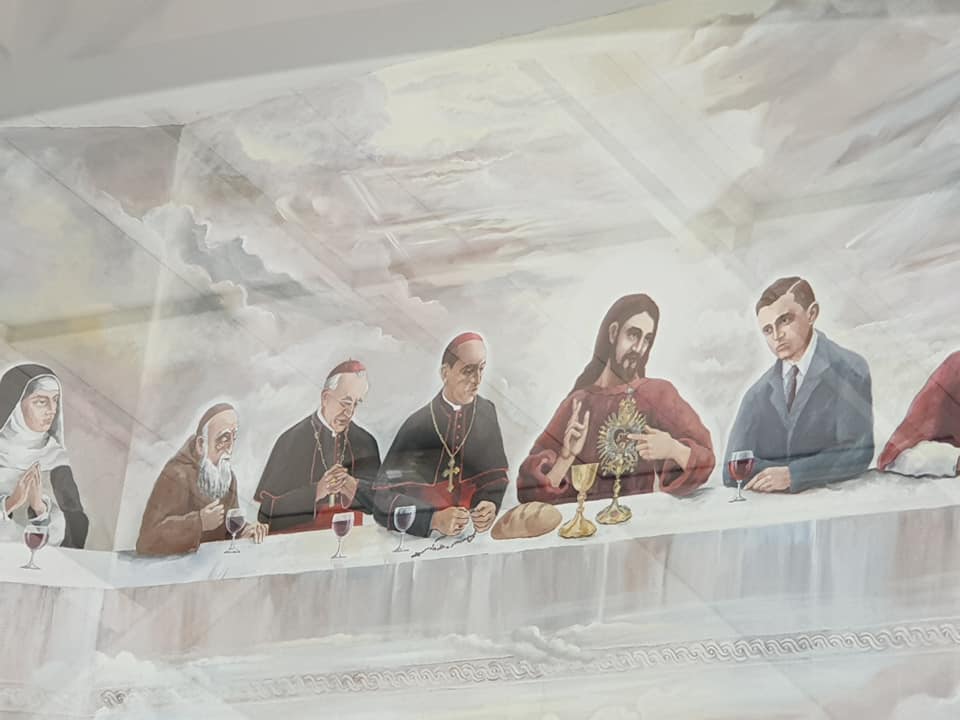
In the 18th century northern Croatia was ravaged by the plague. The people turned to God to call upon His help, and the Croatian Parliament did the same. During the session held on December 15, 1739 in the city of Varazdin, they vowed to build a chapel at Ludbreg in honor of the miracle if the plague ended. The plague was averted, but the promise vow was only fulfilled in 1994, when democracy was restored in Croatia. In 2005 in the votive chapel, the artist Marijan Jakubin painted a large fresco of the Last Supper in which Croatian saints and blesseds were drawn in place of the Apostles. St. John was replaced with Blessed Ivan Merz, who was included among the 18 most important Eucharistic saints in the Church’s history during the Synod of Bishops held in Rome in 2005. In the painting, Christ is holding in His hand a monstrance containing the relic of the Eucharistic miracle.
Croatian speakers can learn more about the miracle in the video above.
And this is where things got rather extraordinary, to me at least. I have asked a LOT of Catholic friends here in recent days if they know about the Ludbreg miracle. Most only knew about Ludbreg as the centre of the world, others knew that there was some kind of pilgrimage in September, but a miracle? The only Vatican-authenticated one in all Croatia that you can actually visit? Not one person.
Amazing.
And yet people DO know about it, at least 100,000 people. For that is the number of pilgrims who gather in Ludbreg each year in the first week of September for a special commemoration of the miracle in the park in front of the church constructed in 1994. Check out some footage from this year's pilgrimage above.

And for the rest of the year, apart from Easter, the church and the park are completely unused.
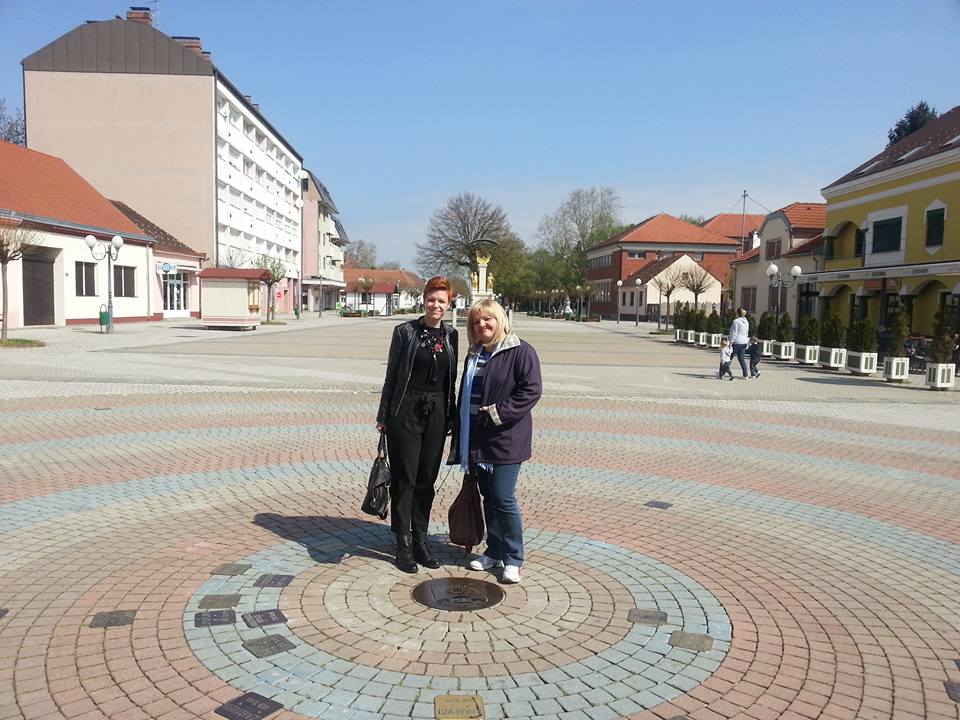
The park comes with its own Stations of the Cross.
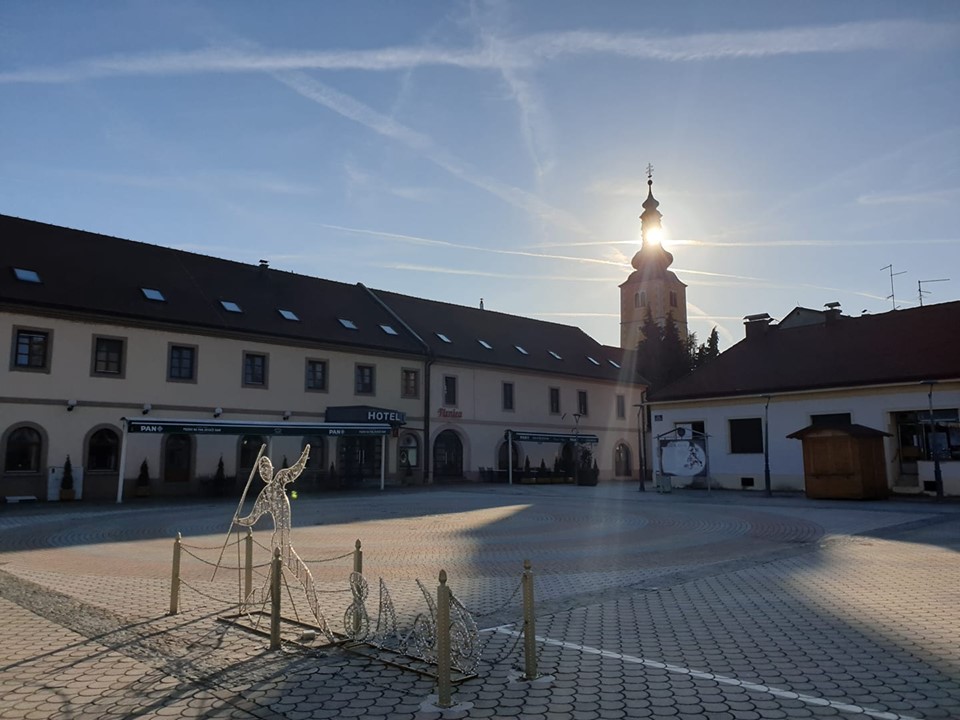
The 1994 church, however, is not where the miracle chalice is held. It is to be found in the Most Holy Trinity Church in the centre of town, just off the main square and the centre of the world.
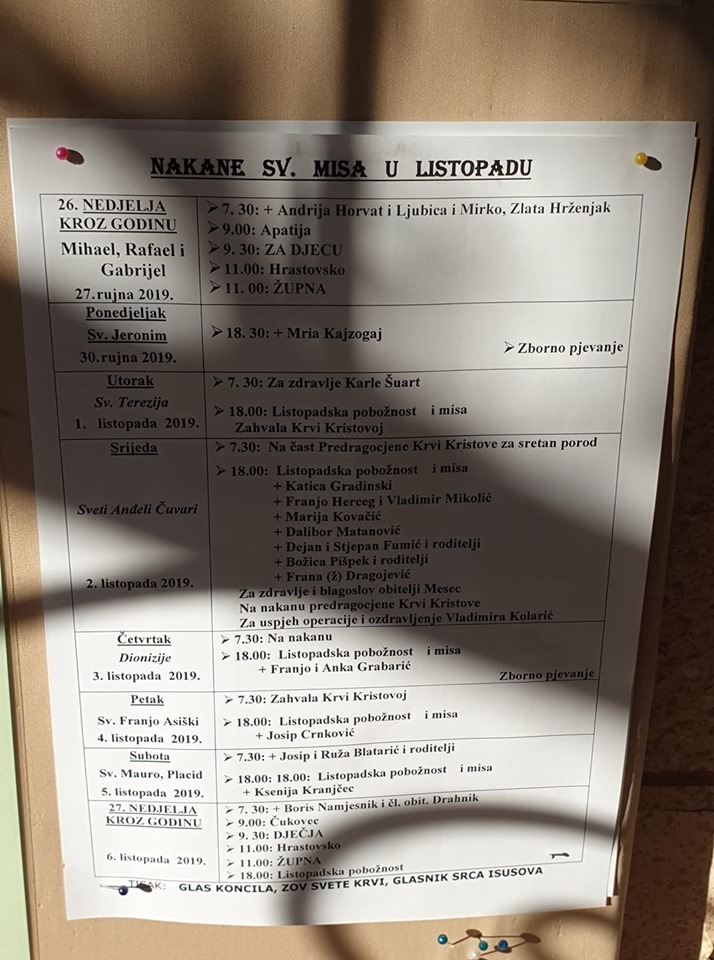
One of the challenges of seeing the miracle chalice is that the church is closed a lot of the time, but with a little careful planning it can be visited every day. For mass is held daily, the chance to worship in the presence of Croatia's only authenticated miracle. Mass times for October above - making this information available online and in English would be easy to do.
And it turns out that this is exactly what is already happening, but on a very limited scale. Ludbreg has a steady trickle of tourists from Poland, I learned. They arrive by bus and spend the night in Ludbreg before attending mass in the morning and continuing their journey to their end destination - Medjugorje. From the town with the authenticated miracle to the town without Vatican approval but with over a million tourists a year.

From what I learned during my last visit to Ludbreg, although the Polish pilgrims go to mass in Ludbreg, they do not visit the original chapel where the miracle took place.

Which is a shame, as it is REALLY pretty and has some rather fascinating things to see is the small exhibition area behind it.
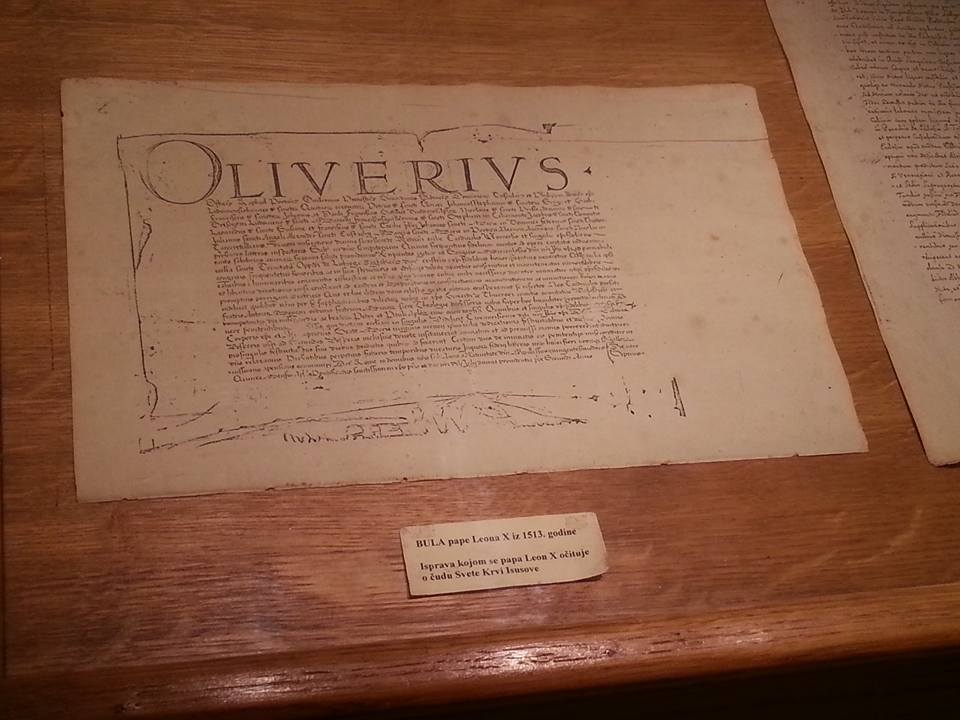
Including the papal bull of Pope Leo X in 1513.
Religious tourism is a niche product, and it is not for everyone, but as Medjugorje has proved, it motivates people to travel. And as Croatia looks to extend its season and develop tourism in continental Croatia, is it sitting once more on a hidden jewel, this time in the niche of religious tourism? If religious tourists from Poland are already coming to Ludbreg, that is proof that this incredible little story is attractive to the niche market. The fact that it is 7.5 hours from Medjugorje and not far off the bus routes of many pilgrims going to Medjugorje by bus from Central Europe surely means that there is a market with captive audience to be developed. Word of mouth passes quickly in such niche markets, and if the majority of Catholics even in Croatia know almost nothing about the Ludbreg miracle, one assumes the same is true elsewhere. But some Poles know about it and are sufficiently interested to visit with the current set up. As I understand it, they are also able to have the mass said in Polish by their accompanying priest.
Imagine if Ludbreg could expand its religious content, as well as better promotion of its authenticated miracle. While nobody is suggesting we have a new Medjugorje in terms of tourist arrivals, that current Polish trickle could turn into a very steady stream. A little thought into better use of the current religious offering in Ludbreg and better promotion is pretty much all that is required.
And the components are already there. Instead of just mass and then an onward journey that the Polish tourists currently experience, include a tour of the original chapel with its gorgeous frescoes. Visit the exhibition by the chapel and learn about the papal bull and more. Stroll over through the park to the 1994 church built in belated thanks for averting an 18th-century plague. Do the Stations of the Cross in the park, then learn more about Croatia's saints in the unique Last Supper fresco to be found at this church. And then perhaps an early lunch - choose from Croatian, Italian, Mexican and American cuisine at the appropriately named Hotel Raj across from the park - Raj in Croatian means 'heaven.'
Too fanciful? I personally don't think so, especially as the Polish pilgrims have already proven the interest.
As I was driving away from Ludbreg, I thought of the possibilities of religious tourism and realised that this is a tourism niche that has been largely overlooked until now. Croatia has some INCREDIBLE religious sites (Blaca Monastery on Brac, say no more) and processions (Za Krizen on Hvar, The Assumption of Mary in Sinj), and some wondrous occurrences that are not certified as miracles (Our Lady of Trsat, the Black Madonna of Marija Bistrica). And yet there is no central exhibition centre or museum where one can learn about Croatia's diverse and truly fascinating religious heritage. So why not build create one and give even more content to visitors. And where better than in the Croatian Miracle Town of Ludbreg - developing tourism continental Croatia and developing a year-round religious tourism niche at the same time? But that perhaps is a topic for another day.
Iva Gerić Wins First European Women's Wrestling Medal for Croatia!
Iva Gerić from Ludbreg has won the bronze medal at the European Wrestling Championships in Faenza, Italy, which is Croatia's first European medal in women's wrestling. Gerić performed in the cadet category and lost in the fight for the final against a wrestler from Ukraine, though her success in the competition is monumental. Gerić is a member of the Ludbreg Wrestling Club and is one of the most talented athletes in Croatia today, writes Podravski.hr on June 22, 2019.
“I knew what I needed to bring home before I was even in Italy. I was ready and I believed that I could. On the first day of the competition, I was blocked, and it wasn’t me on the mat - my mind had a wish, and my body did not cooperate. The next day gave me an opportunity and here we are back with a medal,” Iva said after the medal celebration.
On the way to the bronze medal, Gerić overcame Hungarian, Lithuanian and French representatives. Her loss to a wrestler from Ukrainian secured her third place at the European Championship in the category of up to 61kg.
Led by coach Senada Mujagić, Veronika Dragaš, Nika Slavica Anđelić, and Victoria Vrdoljak competed alongside Gerić at the tournament.
To read more about sport in Croatia, follow TCN’s dedicated page.
Ludbreg Company Offers Workers ''German'' Pay and Benefits
As Sergej Novosel Vuckovic/Poslovni Dnevnik writes on the 26th of May, 2019, Sigetec Ludbreški, part of Ludbreg in Varaždin County, has a population of around only six hundred people, and every day there are more than a hundred workers coming to work at Inoxmont-VS, which deals with metalworking, the concrete assembly of industrial plants and equipment and more.
They manufacture and install industrial process equipment for steel, they perform pre-production and the mounting of brackets, and various other parts of industrial plants. It is definitely difficult and demanding work, but it's fairly paid
There are about 170 people in operation here and abroad as posted workers, and the average salary is about 9,000 kuna. And that's just the starting pay, experienced ''masters'' get up to 23,000 kuna, or 3,000 euros. So, we are not in Germany, where Croats are more than happy to keep heading to, but in the north of Croatia, a county where the average salary is less than 5000 kuna.
How is that possible?
''It's possible with us. And we should point out the fact that since May the 1st, our average salaries are even higher, we raised them by about five percent," said the co-owners of the aforementioned company, Mladen Vidović and Zlatko Sova. They believe that the workforce is the foundation of their business and strives to ensure them the best possible conditions because ''things can only develop in such a way''.
"We're constantly investing in technology, but even moreso in our workforce.For those who work as installers and welders on construction sites and under difficult conditions, we have implemented good work benefits, for a year we pay for fifteen months of their pensions and other allowances. Those who go abroad and work are provided with housing and transportation, only through the care of your employees can you deliver the quality service that is being sought from us,'' say the directors of this Ludbreg company.
Despite the already-described benefits and this Ludbreg company's almost magnetically attractive working conditions, Inoxmont still shares the same fate of many operating within the metal industry, and they're facing a deficit of workers. At the moment, they have open positions.
In the local ''pool'' of Varaždin and Međimurje County, where they have the largest number of workers, there still aren't enough of them, and even the ''production'' of staff from throughout Croatia doesn't look like its going to be promising any time soon. Before even enrolling in high school, minors seem to already be picturing themselves abroad, having run away from the ailing metal industry.
"We talked with the director of the Varaždin Mechanical Engineering School, only six students enrolled in the field of construction in the construction sector, they are the only ones in Croatia who have enrolled in this subject. In vocational professions, of course, there's a lack of qualified workforce, and we're also feeling it.
We also talked to pupils who are interested in the position of CNC operator from Ludbreg High School, and they said that they were going to leave Croatia immediately after completing their schooling, and we tried to explain that they had come out of school without the necessary practical knowledge, ans when they either go to Germany or wherever else, they'd be negotiating not as an equal partner with an employer but would be begging for jobs. Along the same lines, no matter how long they spend in another country, they will always be foreign,''
The co-owners are more than aware of the problems Ludbreg's Inoxmont faces, which, moreover, boasts workers from across the country, as well as from Hungary and Bulgaria.
Their attitude towards the import of labour is therefore clear.
"It's necessary to increase import quotas or just abolish them, but that's a fire-fighting solution, primarily to motivate people and stop them from permanently leaving the Republic of Croatia, but we all have to work on it, we give the maximum, we provide our workers with good conditions, but the Government must stand behind us,'' say Vidovic and Sova.
Make sure to follow our dedicated business page for much more.
Click here for the original article by Sergej Novosel Vuckovic for Poslovni Dnevnik
Lipik and Ludbreg Best Croatian Towns in Using EU Funds
There are 32 towns which have not withdrawn a single euro.
Ludbreg Is Best Croatian Town in EU Funds Usage
As many as 63 towns have not withdrawn a single euro.
Five Things Not to Miss in Ludbreg
Tucked away in Varazdin County is the most unusual little town in Croatia. Five things not to miss in Ludbreg.
Ludbreg: Center of the World and Eco Smart City
The town of Ludbreg, known as the center of the world, has introduced a “smart” waste management system.
Economic Boom in Ludbreg
The town in northern Croatia has one of the lowest unemployment rates in the country.
Tens of Thousands of Pilgrims Gather in Ludbreg
Worshippers visit the Shrine of the Precious Blood of Christ in Ludbreg.

